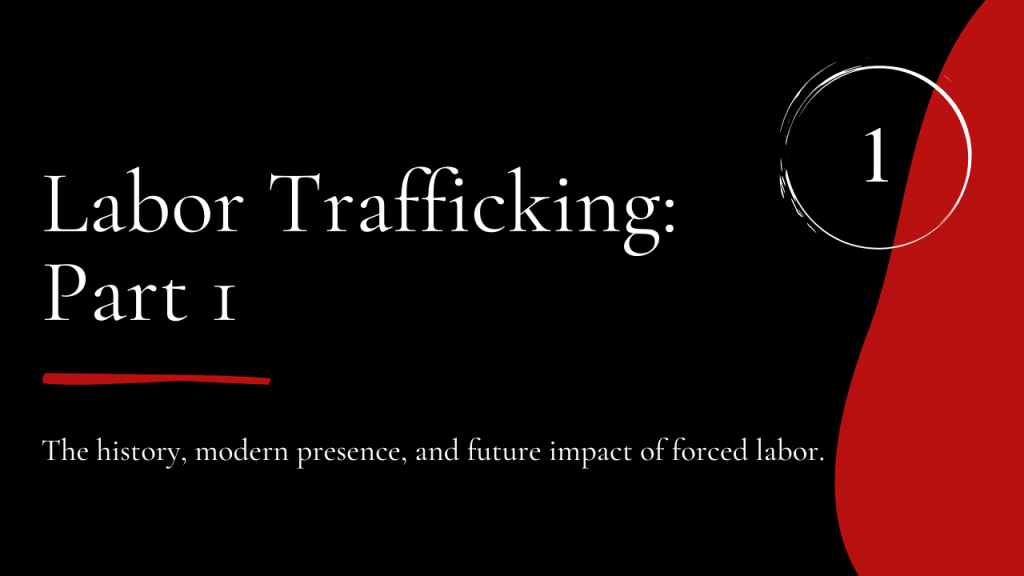Labor Trafficking Part 1: Forced Labor

Show Name: Speaking for the Silenced
Episode Title: Labor Trafficking
Tweet to be shared on the network’s twitter handle: Tune into this week’s episode of #SpeakingfortheSilenced!
In this episode of Speaking for the Silenced the Podcast we will discuss the history, modern presence, and future impact of forced labor. This will be the first episode of a three part segment on forced labor. In the second episode, we will be going in depth on the most common forms of forced labor, and in the third, I’d like to recount to you guys a real life, local story of labor trafficking and what we can do to prevent it in the future.
Segment 1: History of Forced Labor
- Forced labor has been commonplace and diverse in form throughout history, so let’s start from the beginning.
- Its first form can be found in slavery, which began as many as 9000 years ago in Mesopotamia.
- Slavery, as we know, is a form of existence where all self-autonomy and powers are removed.
- Slavery spread West, entered European society
- In certain regions of Europe, particularly the northern regions, slavery was losing relevance and being replaced by serfdom instead, another form of forced labor (around 12th century).
- America fought for independence, took on slavery anyways, irony in doing that, american south especially prominent in doing so
- emancipation proclamation “ended” slavery yet it and other forms of forced labor continued
WW2
- Nazi Germany and Concentration Camps
- Russia and Joseph Stalin’s infamous Gulags
- Examples listed are only the most prominent forms of trafficking as we know it
- UN only formally criminalized human trafficking through the protocols regarding Transnational Organized Crime Groups (TOC) in 2000, just 21 years ago.
Segment 2: Forced Labor’s Modern Presence
- It is estimated that around 21 million people around the world today are caught in some form of forced labor.
- Many of the victims aren’t even visible, human trafficking is very hard to detect.
- Most of these laborers are caught up in the agricultural, mining, construction, and marine industries
- What lies behind the wide-spread use to exploit forced labor is the desire for profit
90% of forced labor can be found in private industries
Example: Bananas in south american countries, such as ecuador:
- Why are they so cheap?
- Underpaying and mistreatment of workers, many of whom are paid less than 10$ a day
- Some of the more exploited aren’t even paid.
- Prison Systems
- Focus on the US prison system, containing the largest percentage of prisoners in the world.
- These prisoners act as laborers during the day, often working in mechanical or industrial factories
- Whether prison labor is forced labor or not is an ongoing, controversial debate.
- Prisoner laborers are paid anywhere between a few cents to a few dollars in a day.
- 13th amendment bans slavery or involuntary servitude unless “as a punishment whereof the party shall have been duly convicted”
- Therefore, prison labor is technically legal.
- Organized prison strike of 2018 called the labor “prison slavery”.
- Line between prison labor and forced labor is very blurred.
- Certain demographics of prisoners are more exploited than others: illegal immigrants + African-Americans.
- Uyghur Persecution
- Chinese Government’s persecution of Uyghurs, a Turkish ethnic group that is predominantly Muslim.
- Chinese Government forcibly removing them from their lands
- Many of them sent to remote so called reeducation camps
- Tens of thousands of Uyghurs are being sent to work long hours in factories against their will
- Many items used in daily life: clothing, electronics, and more have been touched by Uyghur Labor
- Congress passed Uyghur Forced Labor Prevention Act
Segment 3: The Future Impact
- Questions to ask: Why can these people not escape? Why can they not just walk away from their jobs and free themselves from modern slavery?
- Some people are not lucky enough to escape and will spend the rest of their lives working off their debt.
- They will never know a life outside of slavery.
- Mental and physical trauma to those who do escape.
- Human trafficking quite literally takes away your humanity.
- Forced labor creates more economic imbalance in the world.
- Wealth gap will increase: rich get richer, poor get poorer
- People who buy products made by forced labor are and will become even more reliant on those products.
Music Credits:
- Brooklyn and the Bridge by Nico Staf
- At the Restaurant by Monolog Rockstars
Subscribe to our Podcast
- Apple Podcasts
- Spotify
- Google Podcasts
- Stitcher
- YouTube
Connect with us on Social Media
Sources:
- https://www.dhs.gov/blue-campaign/forced-labor
- https://laborrights.org/industries/bananas#:~:text=Unionized%20banana%20workers%20can%20make%20%2410%20a%20day%20or%20more,and%20no%20voice%20at%20work.
- http://www.endslaverynow.org/learn/slavery-today/forced-labor
- https://www.freedomunited.org/prison-labor-and-modern-slavery/
- https://en.wikipedia.org/wiki/Uyghur_Forced_Labor_Prevention_Act
In this episode of Speaking for the Silenced the Podcast we will discuss the history, modern presence, and future impact of forced labor trafficking.

